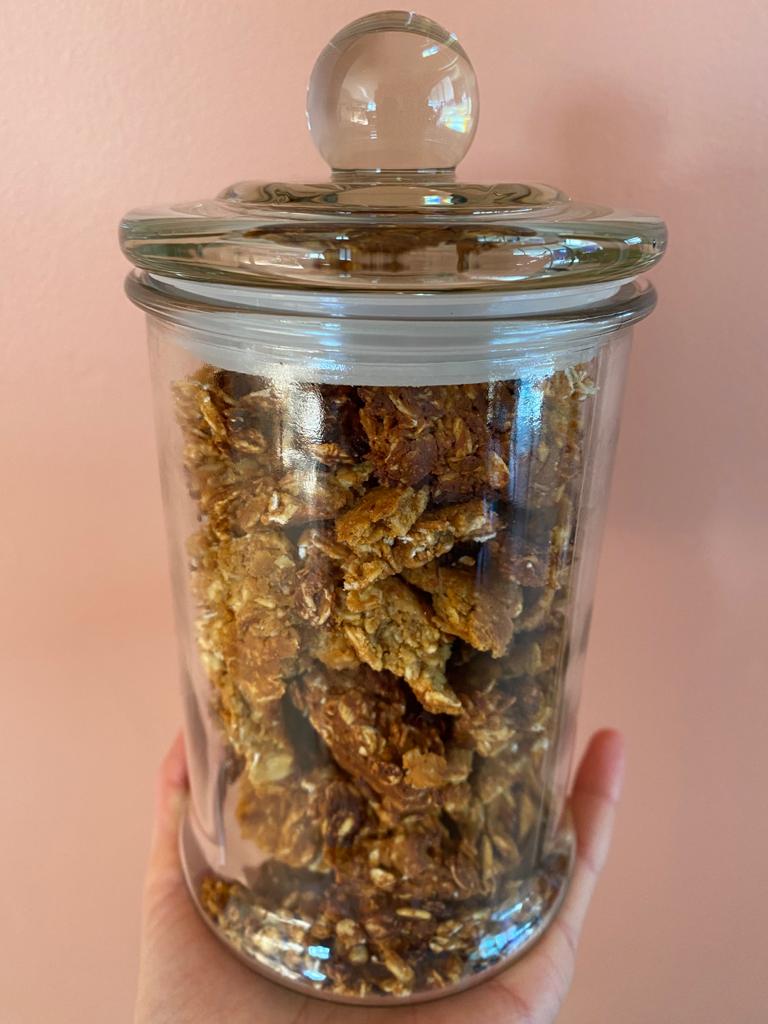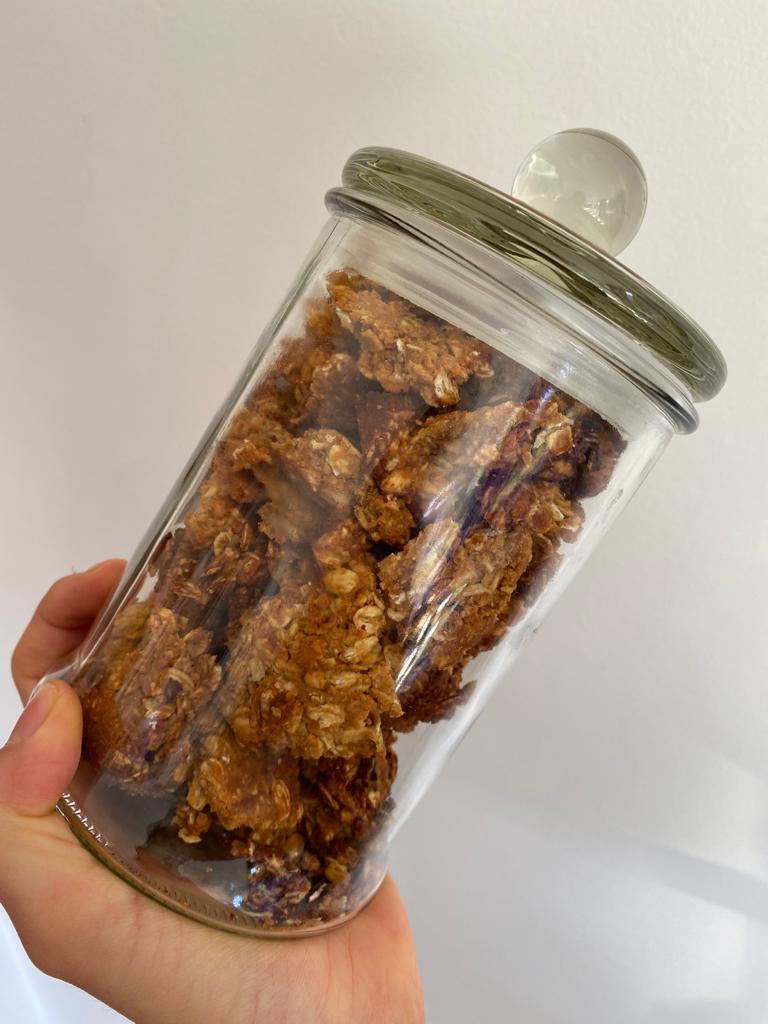
This recipe is for people like me that wish we could eat cake and biscuits for breakfast but, begrudgingly understand it’s not the most healthy or energy-fueling way to start the day. Don’t get me wrong every now and again leftover birthday cake, crumble, celebrations cakes and biscuits will be thouroughly enjoyed for breakfast. Day to day on the otherhand, I want a good breakfast that will fuel my body with sustenance to get on and thrive, containing slow release energy, that will keep me at my optimum until lunch time. THIS RECIPE TICKS BOTH THOSE BOXES. Yep, this granola is so damn chunky & delicious it feels like you’re having a bowl of biscuits for breakfast!
I created this recipe to be quick, one bowl and use store cupboard ingredients. If you prefer more variety in your granola I’d recommend adding puffed grains, leftover cereals, nuts and seeds along with the dry ingredients before cooking. Any dried fruits should be added after cooking to retain their juicy, chewiness and choc chips, peanut butter chips or toffee pieces once the granola has completely cooled.
As you can see in the images, I leave my granola super chunky, in almost boulder size pieces. This way it’s honestly like eating oat cookies and milk for breakfast! You can make the granola smaller by breaking it up more after the first bake or by bashing it up with a rolling pin once its cooled down. If you leave the mix in bigger chunks the final granola will be slightly chewier which I prefer, but if you like it totally crisp make sure you break the granola into marble sized bits halfway through cooking, to achieve a crunchier texture.

Foodie facts: protein – The addition of malt drink and protein powder means 100g of this granola contains 20g of protein! Alongside the fibre from the oats, protein ensures a steady release of energy, as it takes longer for our body to digest and assimilate protein than carbohydrates4. This recipe is great if you worry about meeting your protein requirements, do alot of phyical activity or are injured. Extra protein in your diet can aid recovery of our muscles post-exercise or after injury5.
Foodie facts: plant-based Calcium – For health reasons I need to consume higher than normal levels of Calcium (Ca). Meeting RDA levels of micronutrients on a plant-based diet can be a little more difficult (see this post for explanation) and Ca can be one of the especially pesky ones. Adults aged 19+ require 700mg of Ca per day, 525mg for children under 1 and about 1250mg for breastfeeding women, and menopausal ladies2.
99% of our Ca is stored in our bones and teeth and less than 1% in our soft tissue and bodily fluids2. Calcium is essential for bone deposition, ensuring we build strong, dense bones3. Our bodies deposit Ca in our bones until about the age of 30, so this is when we reach our peak bones mass. It is therfore very important to make sure you are having adequate levels of calcium during this period to create strong, dense bones. Brittle, porous bones are associated with osteoporosis and fractures later in life2. Post 30, our bone density starts to reduce, this is a natural part of ageing however, certain lifestyle factors including; lack of physical activity, hormonal status, diet and the menopause (due to a reduction in oestrogen) all accelerate bone degradation1.
Calcium also has other roles like, ensuring normal blood flow by helping blood vessels contract and relax properly, allowing our nerve cells to carry messages, our muscles to move and is responsible for the release of some hormones3.
Plant food sources of calcium & aiding its absorption – Most people associate dairy as the main calcium source but, there are many plant sources of Ca too. Moreover, having an awareness of other foods that can improve the bioavailabity (how much of a substance is absorbed and can be utilised by our body1) of Ca, will help raise your levels further.
Nowadays most cereals, flour & bread products are fortified with Ca and because we consume large volumes of these foods they count as a good source. Other foods include soya products like tofu (510mg/100g, providing the coagulent used is NOT nigari), sesame seeds 670mg/100g, dried figs 250g/100g, almonds 240mg/100g, hazelnuts, sunflower seeds, watercress, kale, broccoli, peas, beans and both sweet & white potatoes1. Malted milk drinks are a rich source of micronutrients including Ca. Depending on the type of malted milk drink you use (containing dairy or not) Ca content can range between 220-710mg/25g serving. This makes it a really easy option for boosting your Calcium levels. Whilst sesame seeds contain higher levels of Ca than say malt drink, its very unlikely you would eat 100g in one sitting, more like 10g. So it’s important to work out, the volume of foods you are comfortable eating and whether that will give you satisfactory levels of micronutrients.
An annoying problem with some plant foods is that they contain high levels of oxalic, phytic and uronic acids, which inhibit the body from absorbing Calcium from the food. Spinach, sorrel, rhubarb, walnuts, celery, okra and beans contain these acids and whilst they do contain high levels of Calcium too it can’t be utilised because of the acids’ presence1. Moreover, Oxalic acid can also reduce how much Calcium you can absorb from other foods eaten at the same time1. This doesn’t mean you need to avoid eating these foods as they are still good sources of other micro and macronutrients. For example, walnuts are a great source of healthy omega fats and beans are a vital protein source especially if you follow a plant-based diet. Kale, broccoli, peas, beans and both sweet & white potatoes all have lower oxalic acid levels1 soya beans contain uronic acid and beans Phytic6. Fortunately, these acids can be reduced to some degree by the food manufacturing process, cooking and our own digestion and fortunately unlike some micronutrients Calcium levels are not lost during cooking1.
Having good levels of Vitamin D aids Calcium absorption whereas excess phosphorus can inhibit absorption. Similarly, too much salt can reduce our levels of Ca because the body uses stored Ca from our bones to remove excess salt via our urine3. Caffeine has been shown to slightly reduce Calcium absportion but the presence of protein in a meal can really help with improving bioavailability1.
The world of nutrition and healthy eating on a plant-based diet especially can seem very overwhelming as there are so many clauses and conflict between different foods, how they affect other foods and how they react in the body. My aim is not to get people worked up over which foods they should be pairing, when they should be drinking caffeine, if its too much or too little. My hope is that nutritional education provides undertsanding and empowerment to take control of our plates, and to be mindful that we are getting enough variety in our diet and enough volume of foods that provide micronutrients, especially if one is following a plant-based lifestyle.
Everyone needs this granola in their life! The recipe is foolproof, quick to prepare, will please all the family, keeps well and honestly tastes so delicious it rivals every shopbought alternative. Don’t believe me? Well you’ll have to bake it to find out…
(This recipe makes about 300g of granola)
- 150g oats
- 50g malt drink (I use vegan horlicks) – if you can’t get hold of malt drink sub for 50g plain flour and 25g extra syrup
- 50g protein powder of choice – I use a plain, unflavoured powder but, I’ve deliberately made the granola less sweet as I know most people use flavoured powders which have added sweetness so hopefully you won’t find this granola sickly. But, feel free to play around with the ratio or syrup to milk to suit your taste buds. Don’t forget eating this granola with plant/dairy milk/yogurt will also bring out the sweet taste.
- 50g syrup of choice (e.g. fruit syrup, maple, honey, agave etc)
- 80g milk of choice (I’ve used both oat and soya in the past)
- 20g vegan butter (melted)
METHOD:
1. Preheat the oven to 190 or 180 degree celcius for fan assisted ovens.
2. Add all the dry ingredients to a large bowl and mix so that protein, malt/flour and oats are evenly dispersed. Avoid chucking all the ingredients in at once as protein powder likes to clump together when liquid is added and lumps of protein powder will taste gross in the end.
3. Now add the wet ingredients and stir until the dry are evenly coated in the wet. Line a roasting tray/9inch square cake tin/or pie dish with baking paper. Tumble the raw granola into the dish, squash and compact the mix into one large flapjack like shape, about 1 inch thick.
4. Bake for 15 minutes, remove from the oven and break the giant flapjack into large pieces and flip them over, the underside will be more golden than the top. Bake for a further 10 minutes. Remove from the oven, the granola should be evenly golden. Break the granola into nuggets and then leave in the tin to cool completely. Store in a clean, airtight container. It will last 1-2 weeks at room temperature.
RESOURCES:
1. Dr H. Theobald (2005) Dietary Calcium and health Available at; Dietary calcium and health – British Nutrition Foundation
2. BDA (March 2021) Calcium Available at; Calcium (bda.uk.com)
3. EUFIC (11 Jan 2021) Calcium; foods, functions, how much do you need & more Available at; Calcium: foods, functions, how much do you need & more | Eufic
4. R. Andrews (2021) All about protein Available at; All about protein: What is it and how much do you need? (precisionnutrition.com)
5. M Abdullah, A Ahmed, S Wafa et al (May 2020) ‘Determination of calorie and protein intake among acute and sub-acute traumatic brain injury patients’ Chinese Journal of traumatology Available at: Determination of calorie and protein intake among acute and sub-acute traumatic brain injury patients – ScienceDirect
6. M. Freidman (January 1996) ‘Nutritional Value of Protein from Different Food Sources. A Review’ Journal of Agricultural and Food Chemistry Available at; Nutritional Value of Proteins from Different Food Sources. A Review | Journal of Agricultural and Food Chemistry (acs.org)

